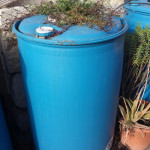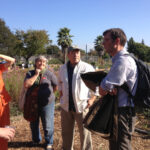Smooth or Chunky
In the gardens of my youth, the soil texture was definitely chunky. Chunky then meant sandstone and shale rock pieces – chunks so hard you could not break them with a pick, let alone with the tender root of a seedling. Smooth was what was left over when the chunks of rock were removed and pitched over the cliff! Smooth was fine textured, powdered sandstone.
In those days, my mother was the gardener and I was the observer. Organic methods were not widely publicized. My mother used peat moss (now discouraged for conservation and ecological purposes[i]). She used multiple brand name soil additives that came in colorful bags, adding, adding, adding year after year with hopes to improve the fertility and texture of her soil.
In the garden of the first house I really and truly owned, chunky meant the roots of the monster-sized mature trees that someone had planted far too close together when the development was new. Chunky was what your shovel hit every time you tried to penetrate with a shovel. Smooth was the top surface, where water hydroplaned right off the property into the street gutter. Not an inviting garden space, so container gardening became my forte. Potting soil – now that’s smooth. If you look at it closely there is a slight texture, but on the sliding scale of things it is definitely smooth.
A visit to a conventional farm space when my kids were young was shocking. At 70mph freeway drive-by glance, farm soil appeared to be smooth, as far as the eye can see. Yet when we left the drive-by scene and got up-close and personal, the plough had made huge knobby chunks of the earth. The squash vines were abundantly happy amongst all of those grapefruit-sized clods. Why then, are we city gardeners so preoccupied with smooth?
In my current garden space, smooth and chunky have run the gamut. Smooth described my garden soil when I first arrived – very sandy, with that familiar hydroplaning surface tension. Our first batch of homemade compost was very chunky: moist clods complete with whole avocado and peach pits and intact eggshell halves.
I wasn’t sure that “chunky” was how compost should be, but then my husband and I were compost beginners. After all, the expensive bagged compost from the garden center was smooth and fine textured. A gentle breeze could scatter it from your open palm. Obviously smooth must be the standard for “correct” compost, and my chunky homemade nonsense seemed quite deficient!
I soon realized that a large part of my chunky compost was balls of living worm bodies, tightly nestled and writhing together to devour a choice morsel. Garden center compost had none of these chunks, instead sitting dry and uninhabited and sterile in its brightly colored bag. Now the purchased stuff needed the perky label to persuade me how “organic” it was!
I ventured into the world of mulching, beginning with found materials like fallen leaves (chunky), and sawdust (combination smooth and chunky). In the space of a year or two, the powers-that-be in the garden turned all of that to smooth: a relatively fine textured, moist, delicious, critter-rich dark soil. Another foray into mulch involved the small bark chips sold in bags at the garden center (definitely chunky). I wondered if my soil would ever recover, or whether I would be digging lumps for all eternity.
Then came the “aha” moment, with the delivery of a massive free truckload of chipped tree trimmings for mulch. Now THAT was chunky! Branch chips larger than my hand, among chipped leaves that lay dusty green and delicate. My father (still living at the sandstone and shale address) laughed at me and declared I’d be picking chunks out of my garden for all eternity. Yet even as I distributed the Mulch Mountain into various beds around my property, I noticed a “forest floor” effect taking place. It looked like the ground beneath tall trees where the natural leaf litter falls and twigs are a normal part of the soil texture. Beyond visual, the plants’ vigor and moisture retention were superb. My new garden had a sense of “ahhhhhh…” about it. It smelled right.
The neatly raked and leaf-blower-swept smooth soil surfaces of my neighbors looked stark, peaked and barren by comparison. Even though their soils were smooth to my “definitely chunky,” there was a sense of earthiness to my garden. It felt right. Isn’t that the way nature intended it?
[i] http://www.motherearthnews.com/ask-our-experts/peat-moss-to-improve-soil.aspx


